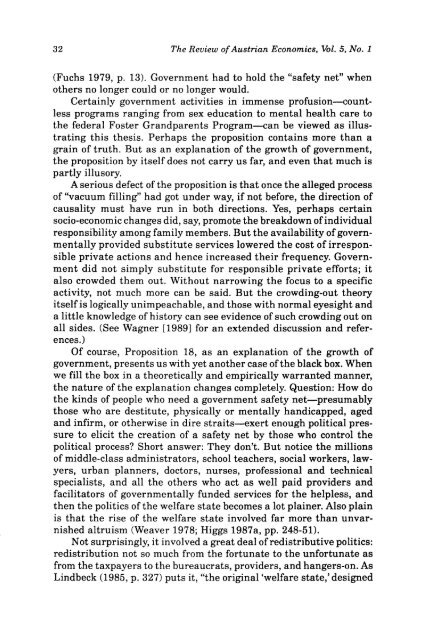Review of Austrian Economics - The Ludwig von Mises Institute
Review of Austrian Economics - The Ludwig von Mises Institute
Review of Austrian Economics - The Ludwig von Mises Institute
You also want an ePaper? Increase the reach of your titles
YUMPU automatically turns print PDFs into web optimized ePapers that Google loves.
32 <strong>The</strong> <strong>Review</strong> <strong>of</strong> <strong>Austrian</strong> <strong>Economics</strong>, Vol. 5, No. 1<br />
(Fuchs 1979, p. 13). Government had to hold the "safety net" when<br />
others no longer could or no longer would.<br />
Certainly government activities in immense pr<strong>of</strong>usion—countless<br />
programs ranging from sex education to mental health care to<br />
the federal Foster Grandparents Program—can be viewed as illustrating<br />
this thesis. Perhaps the proposition contains more than a<br />
grain <strong>of</strong> truth. But as an explanation <strong>of</strong> the growth <strong>of</strong> government,<br />
the proposition by itself does not carry us far, and even that much is<br />
partly illusory.<br />
A serious defect <strong>of</strong> the proposition is that once the alleged process<br />
<strong>of</strong> "vacuum filling" had got under way, if not before, the direction <strong>of</strong><br />
causality must have run in both directions. Yes, perhaps certain<br />
socio-economic changes did, say, promote the breakdown <strong>of</strong> individual<br />
responsibility among family members. But the availability <strong>of</strong> governmentally<br />
provided substitute services lowered the cost <strong>of</strong> irresponsible<br />
private actions and hence increased their frequency. Government<br />
did not simply substitute for responsible private efforts; it<br />
also crowded them out. Without narrowing the focus to a specific<br />
activity, not much more can be said. But the crowding-out theory<br />
itself is logically unimpeachable, and those with normal eyesight and<br />
a little knowledge <strong>of</strong> history can see evidence <strong>of</strong> such crowding out on<br />
all sides. (See Wagner [1989] for an extended discussion and references.)<br />
Of course, Proposition 18, as an explanation <strong>of</strong> the growth <strong>of</strong><br />
government, presents us with yet another case <strong>of</strong> the black box. When<br />
we fill the box in a theoretically and empirically warranted manner,<br />
the nature <strong>of</strong> the explanation changes completely. Question: How do<br />
the kinds <strong>of</strong> people who need a government safety net—presumably<br />
those who are destitute, physically or mentally handicapped, aged<br />
and infirm, or otherwise in dire straits—exert enough political pressure<br />
to elicit the creation <strong>of</strong> a safety net by those who control the<br />
political process? Short answer: <strong>The</strong>y don't. But notice the millions<br />
<strong>of</strong> middle-class administrators, school teachers, social workers, lawyers,<br />
urban planners, doctors, nurses, pr<strong>of</strong>essional and technical<br />
specialists, and all the others who act as well paid providers and<br />
facilitators <strong>of</strong> governmentally funded services for the helpless, and<br />
then the politics <strong>of</strong> the welfare state becomes a lot plainer. Also plain<br />
is that the rise <strong>of</strong> the welfare state involved far more than unvarnished<br />
altruism (Weaver 1978; Higgs 1987a, pp. 248-51).<br />
Not surprisingly, it involved a great deal <strong>of</strong> redistributive politics:<br />
redistribution not so much from the fortunate to the unfortunate as<br />
from the taxpayers to the bureaucrats, providers, and hangers-on. As<br />
Lindbeck (1985, p. 327) puts it, "the original 'welfare state,'designed

















